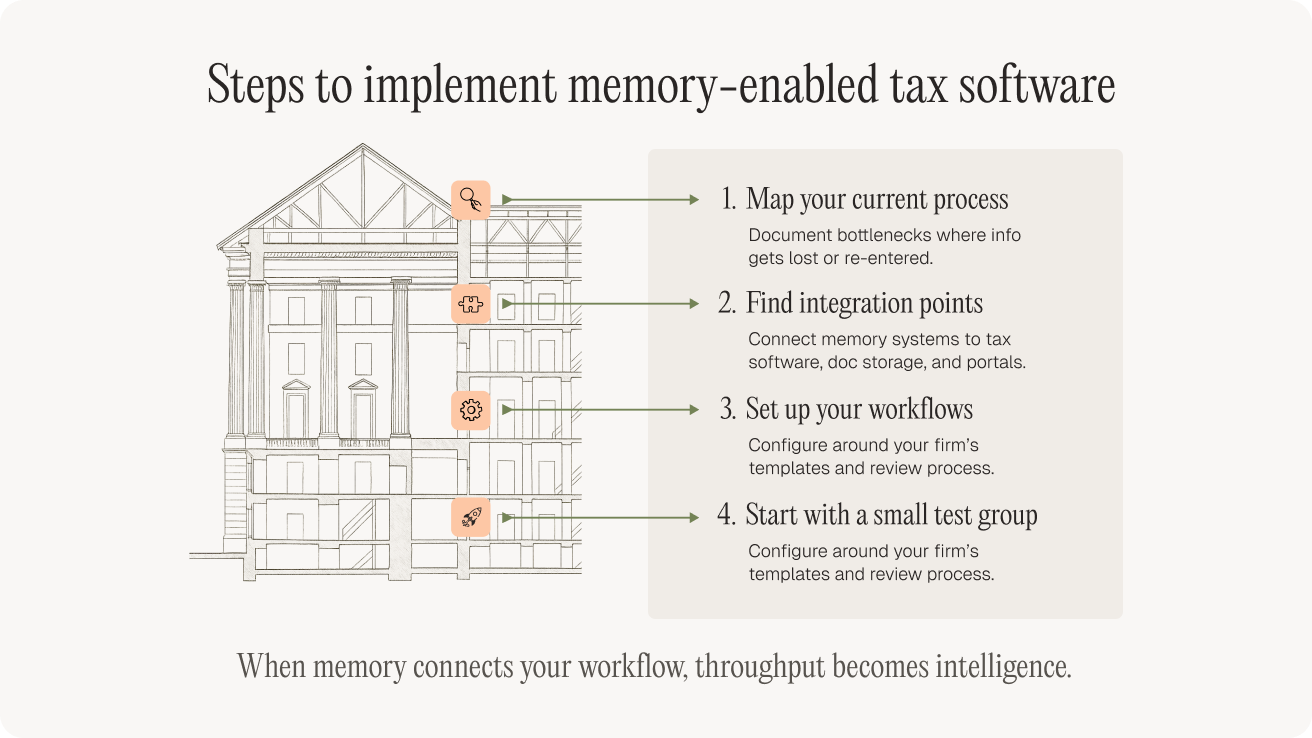Tax season exposes every weak spot in a firm’s workflow. Endless paperwork, long hours, and short-staffing issues, anyone?. AI tax prep tools promise relief, and they deliver speed on tasks like data entry, form filling, and document sorting.
But most AI stops short of what firms really need. Workflow memory.
Without memory, AI treats every task as an isolated step. With it, the system connects every decision across the return, remembers context, and applies rules consistently from start to finish.
Workflow memory makes the difference between a tool that just automates typing and a system that actually thinks like a tax preparer.
What is workflow memory in AI tax preparation?

Workflow memory is AI’s ability to retain context throughout the entire prep process. It remembers what happened earlier and uses it to guide later steps.
Example: a client uploads a receipt for a charitable donation. With workflow memory, the AI remembers it, links it to the correct deduction, and applies IRS rules automatically.
Think of it like the difference between a conveyor belt of workers each doing one task vs. an experienced preparer who handles every step of the return and tracks each decision from intake to filing.
Why conventional AI tools fall short without context
Most AI tools are task-based. They automate one step at a time but don’t remember what came before. That creates problems like:
- Data Fragmentation: Numbers are scattered across disconnected systems, making tracking nearly impossible.
- Contextual Amnesia: The AI forgets prior steps, forcing duplicate work or manual intervention.
- Regulatory Blindness: Rules get applied inconsistently, if at all, across the return.
That’s why review takes so long. Instead of a clear audit trail, CPAs have to chase down which doc supported which deduction.
How workflow memory enhances compliance and traceability
Workflow memory creates an audit-ready trail. Every number on a return can be traced back to its source — a W-2, receipt, or calculation. No digging through inboxes. No mystery deductions.
This traceability is vital during tax season when firms process hundreds or thousands of returns.
It also applies tax law updates consistently across the workflow. Instead of manually re-checking every return, AI with memory pushes updates instantly.
“The biggest time-waster in tax preparation isn’t data entry — it’s figuring out where numbers came from during review.” – Thomson Reuters’ 2023 State of the Tax Professionals Report
Common misconceptions about AI memory and tax automation
Many accountants have concerns about AI in tax preparation, but understanding workflow memory helps address these misconceptions:
❌ Misconception: AI can’t handle complex tax logic.✅ Reality: With workflow memory, AI tracks multi-step rules across the return.
❌ Misconception: AI is a black box.✅ Reality: Memory creates transparency. Every step is logged and traceable.
❌ Misconception: AI requires new workflows.✅ Reality: Memory-enabled systems connect with the tax software you already use.
❌ Misconception: AI increases compliance risk.✅ Reality: Memory reduces risk with consistency and audit trails.
Addressing barriers to adoption in accounting workflows
Despite the benefits, some firms hesitate. Let's address common concerns:
Security and data handling
Workflow memory systems use encryption, strict access controls, and audit logs. In many cases, they exceed a firm’s current security standards.
Budget and ROI concerns
ROI is straightforward: save hours, reduce errors, expand capacity.
- Saving 2 hours per return across 500 returns = 1,000 hours.
- At $100/hour, that’s $100,000 in productivity reclaimed.
Resistance to new technology
The learning curve is minimal. These tools run inside existing workflows. Most firms start with a pilot batch of returns, build confidence, then scale.
Steps to implement memory-enabled tax software

Adding workflow memory to your tax practice doesn't have to be complicated. Here's a straightforward approach:
1. Map your current process
Document bottlenecks where info gets lost or re-entered.
2. Find integration points
Connect memory systems to tax software, doc storage, and portals.
3. Set up your workflows
Configure around your firm’s templates and review process.
4. Start with a small test group
Begin with a few client returns to test the system. Track performance, gather team feedback, and make adjustments as needed.
Moving forward with smarter tax prep solutions
Workflow memory solves the fundamental limitation of current AI –- context. It connects every decision across the workflow, builds transparency, and applies rules consistently.
The payoff:
- More capacity without new hires
- Fewer errors and stronger compliance
- Clearer audit trails that build client trust
Filed is building workflow memory directly into our platform. It plugs into your current software, adapts to your workflows, and delivers review-ready returns with compliance baked in.
Apply for early access to see how workflow memory can transform your tax practice.
FAQs about workflow memory
What tax workflows benefit most?
Complex returns with multiple data sources, multi-state filings, or heavy documentation.
How does it handle state regulations?
Workflow memory applies state-specific rules automatically, logging how each was applied.
Will staff need technical training?
No. Filed is designed for tax pros, not programmers. Training focuses on review, not coding.
How does it integrate with existing software?
Filed connects through secure APIs — no manual transfers. It works alongside your current tax software.




.png)

